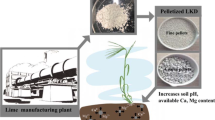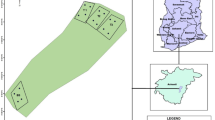Abstract
There are about 1.8 Mt (2 million st) of discarded dolomitic-limestone tailings from the Gays River lead/zinc mining operation in Nova Scotia currently stockpiled in a tailings pond at the mill site. Neutralization effectiveness similar to an agricultural grade limestone and low contents of residual metals make the tailings a potential source of soil conditioner material for the local market. However, the fine particle size, 98% passing 147 µm (about 100 mesh), and a moisture content of 20% make their handling, shipping, and application to soils difficult. The tailings were agglomerated into small hard pellets with various amounts of soil nutrients, moisture content less than 13%, and pH values ranging from 6.5 to 8.7.
Similar content being viewed by others
Explore related subjects
Discover the latest articles, news and stories from top researchers in related subjects.References
Anon., 1980, Editorial, “Evaluating Agricultural Limestones,” Pit & Quarry, Vol. 72, No. 11, May, pp. 87–90.
Atlantic Soil Fertility Committee Council of Maritimes Provinces, 1979, “Atlantic Soils Need Lime,” Bulletin, Nova Scotia Department of Agriculture, pp. 1–6.
Branch, S.N., 1980, “ESSO’s Gays River Mine Newest Nova Scotia Lead-Zinc Producer,” Canadian Mining Journal, No. 4, April, pp. 68–73.
“Guidelines for Sewage Sludge Utilization on Agricultural Land,” 1978, Ad Hoc Committee of the Ontario Ministries of Agriculture and Food, Environment and Health, April.
Harrison, J.L., 1981, Personal Communications, FMCE, Head of Environmental Dept., Imperial Oil Refinery, Dartmouth, N.S.
MacLean, K.S., and Langille, W.M., 1976, “The Extractable Trace Element Content of Acid Soils and the Influence of pH, Organic Matter and Clay Content,” Communication in Soil Science Plant Analysis, Vol. 7, No. 9, September, pp. 777–785.
MacLean, K.S., and Langille, W.M., 1983, “The Extractable Trace Element Content of Coarse Textured Annapolis Valley Soils and the Influence of pH, Organic Matter and Clay Content,” Communication in Soil Science Plant Analysis, Vol. 14, No. 6, June, pp. 463–469.
Robinson, N., 1979, “Profile of Nova Scotia’s Agricultural Sector,” Report, Nova Scotia Department of Agriculture and Marketing, 74 pp., Table B.6, p. 69.
Rockwell, M.R., and Sherwood, H.G., 1983, “Potential Uses of Tailings Produced by Gays River Mine, N.S.,” Paper No. 94, presented at the 86th Annual General Meeting of the Canadian Institute of Mining & Metallurgy, April 15–19, Ottawa, Canada.
Author information
Authors and Affiliations
Additional information
SME preprint 85–102, SME-AIME Annual Meeting, New York, NY, February 1985. MMP paper 85–638.
Rights and permissions
About this article
Cite this article
Rockwell, M.C. Improving the characteristics of fine dolomitic-limestone tailings by agglomeration with selected materials. Mining, Metallurgy & Exploration 3, 237–239 (1986). https://doi.org/10.1007/BF03402487
Received:
Published:
Issue Date:
DOI: https://doi.org/10.1007/BF03402487




